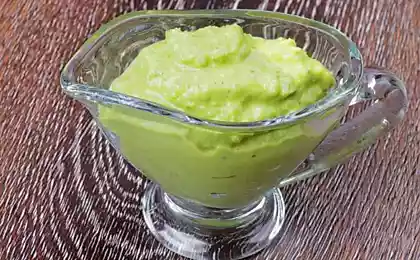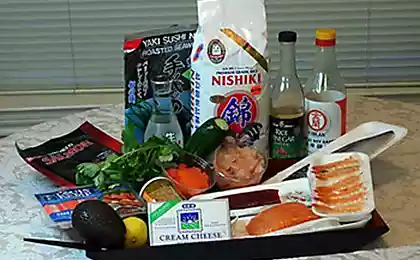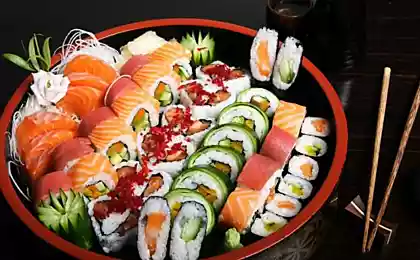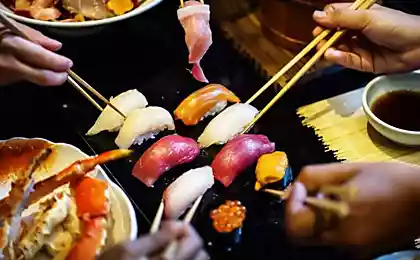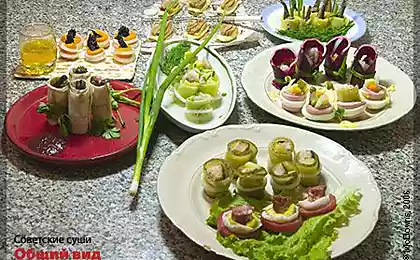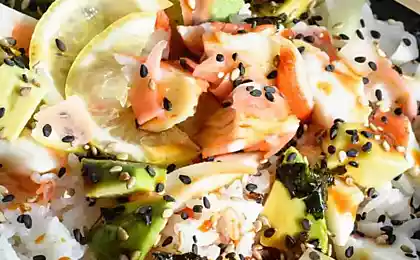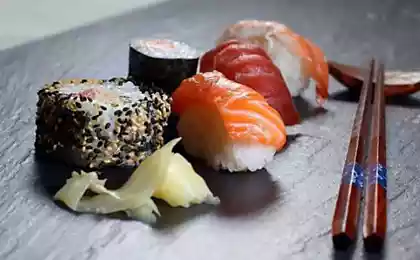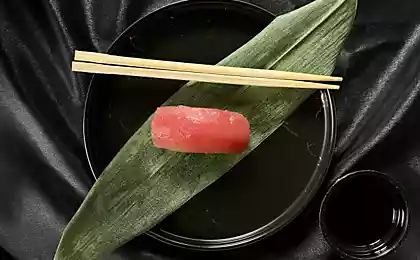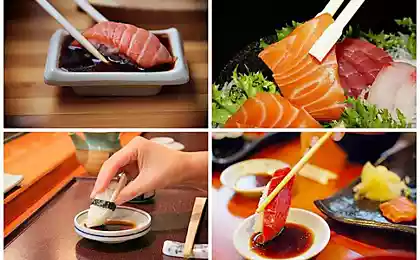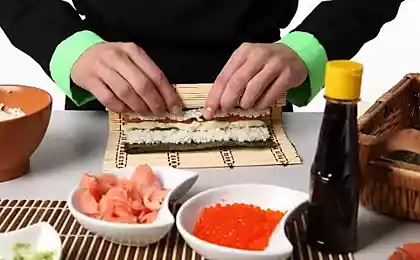493
The imitation game: Secret of wasabi Japanese restaurants
In our blog we write about how restaurants automatiseret their work with the help of special systems, taking care of the comfort of the visitors by using correct light and sound, and also use psychological tricks to increase the average check.
But there are still quite a lot of outstanding issues. One of those rarely discussed topics is the fact that some products and ingredients in the restaurant are not what they are considered by many customers.
The most striking example of this is a condiment wasabi, which invariably accompanies the dish with sushi and rolls in the schools of Japanese cuisine. As noted by The Washington Post, wasabi Japanese restaurant has little to do with real wasabi.
What is wasabi in Japanese restaurantswith sushi rolls "spicy tuna" (known as "spicy tuna") in sushi restaurants serve a mixture of grated horseradish diluted green food coloring, various types of mustard and, as often happens, mixed with many other chemicals.
Trevor Corson, author of "the Story of sushi: an incredible Saga of raw fish" (Trevor Corson, "The Story of Sushi: An Unlikely Saga of Raw Fish"), spoke rather sharply about wasabi a few years ago:
"[...] it's just an old fuck with a mix of mustard extract, citric acid, yellow dye # 5 and blue dye # 1. She [the imitation wasabi] comes in large industrial containers, in the form of a powder, and cook before they serve wasabi on the table, dissolve the powder in water to make a spicy paste".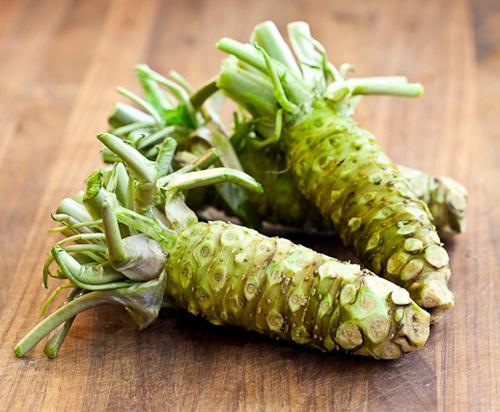
Here is the plant wasabi
Real wasabi is very different from imitation.
It is obtained from the stem of wasabi plants, which, growing up, reaches a length of about 70 cm, and it is very difficult to collect. Often sell stalks and served to the table just grated. Korson wrote:"the real wasabi more refined, complex and sweet taste than all of imitation wasabi, which you used to do".
The elusive wasabiReal wasabi is so rare that it tasted quite a few people. "Real wasabi is hardly possible to find, and fakes a lot," said Brian Oates, President of Pacific Coast Wasabi, which calls itself "the only North American manufacturer of high quality commercial wasabi".
"Probably about 99% of all wasabi in North America – simulation". Basically the same as everywhere else. And even in Japan, although some people may not be aware of it. "I would say that in Japan, about 95 percent of wasabi is imitation" – he added.
Hiroko Shimbo, the sushi chef and the author of the book "the Experience [of making] the land" (Hiroko Shimbo – "The Sushi Experience"), agrees. She said, "99 % – quite close to the truth, though, probably, 95% is more accurate."According to OTS, even in cases when you use real wasabi, its share in the composition of pastes is extremely small – less than 1 percent.
The OTS says that the real reason [mass imitation wasabi] is that fresh real wasabi is rarely served mainly for economic reasons. The demand is much greater than supply (mostly because wasabi is difficult to grow and difficult to care) – so it was a long time.
In the end, to serve freshly grated wasabi visitors to a sushi restaurant, or even sell packages of dried roots is expensive. This means that it will need to sell for a higher price than many would like to pay from $3 to $5 dollars for one regular ball of wasabi, served with sushi.
Instead of expensive combine raw fish with a popular but expensive and fragrant real wasabi, the industry invented a much cheaper alternative – the simulation.
And you did it well before sushi became popular in the United States. "For the first time it came up in Japan, before sushi came to America," he said Simba. "People who love food, like "foodies" from new York probably know about this, but most – definitely not". published
P. S. And remember, only by changing their consumption — together we change the world! ©
Join us in Facebook , Vkontakte, Odnoklassniki
Source: geektimes.ru/company/jowi/blog/263680/
But there are still quite a lot of outstanding issues. One of those rarely discussed topics is the fact that some products and ingredients in the restaurant are not what they are considered by many customers.
The most striking example of this is a condiment wasabi, which invariably accompanies the dish with sushi and rolls in the schools of Japanese cuisine. As noted by The Washington Post, wasabi Japanese restaurant has little to do with real wasabi.
What is wasabi in Japanese restaurantswith sushi rolls "spicy tuna" (known as "spicy tuna") in sushi restaurants serve a mixture of grated horseradish diluted green food coloring, various types of mustard and, as often happens, mixed with many other chemicals.
Trevor Corson, author of "the Story of sushi: an incredible Saga of raw fish" (Trevor Corson, "The Story of Sushi: An Unlikely Saga of Raw Fish"), spoke rather sharply about wasabi a few years ago:
"[...] it's just an old fuck with a mix of mustard extract, citric acid, yellow dye # 5 and blue dye # 1. She [the imitation wasabi] comes in large industrial containers, in the form of a powder, and cook before they serve wasabi on the table, dissolve the powder in water to make a spicy paste".

Here is the plant wasabi
Real wasabi is very different from imitation.
It is obtained from the stem of wasabi plants, which, growing up, reaches a length of about 70 cm, and it is very difficult to collect. Often sell stalks and served to the table just grated. Korson wrote:"the real wasabi more refined, complex and sweet taste than all of imitation wasabi, which you used to do".
The elusive wasabiReal wasabi is so rare that it tasted quite a few people. "Real wasabi is hardly possible to find, and fakes a lot," said Brian Oates, President of Pacific Coast Wasabi, which calls itself "the only North American manufacturer of high quality commercial wasabi".
"Probably about 99% of all wasabi in North America – simulation". Basically the same as everywhere else. And even in Japan, although some people may not be aware of it. "I would say that in Japan, about 95 percent of wasabi is imitation" – he added.
Hiroko Shimbo, the sushi chef and the author of the book "the Experience [of making] the land" (Hiroko Shimbo – "The Sushi Experience"), agrees. She said, "99 % – quite close to the truth, though, probably, 95% is more accurate."According to OTS, even in cases when you use real wasabi, its share in the composition of pastes is extremely small – less than 1 percent.
The OTS says that the real reason [mass imitation wasabi] is that fresh real wasabi is rarely served mainly for economic reasons. The demand is much greater than supply (mostly because wasabi is difficult to grow and difficult to care) – so it was a long time.
In the end, to serve freshly grated wasabi visitors to a sushi restaurant, or even sell packages of dried roots is expensive. This means that it will need to sell for a higher price than many would like to pay from $3 to $5 dollars for one regular ball of wasabi, served with sushi.
Instead of expensive combine raw fish with a popular but expensive and fragrant real wasabi, the industry invented a much cheaper alternative – the simulation.
And you did it well before sushi became popular in the United States. "For the first time it came up in Japan, before sushi came to America," he said Simba. "People who love food, like "foodies" from new York probably know about this, but most – definitely not". published
P. S. And remember, only by changing their consumption — together we change the world! ©
Join us in Facebook , Vkontakte, Odnoklassniki
Source: geektimes.ru/company/jowi/blog/263680/
10 highly effective exercises for losing weight after childbirth
Georgian appetizer of spinach: very simple and incredibly delicious!
